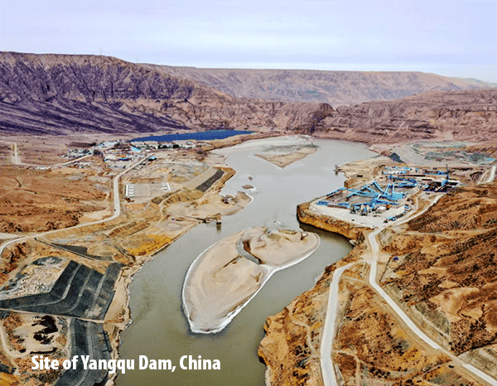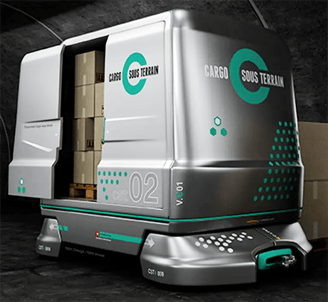What's New in Robotics? 22.07.2022

Posted on Jul 22, 2022 8:16 AM. 8 min read time
News briefs for the week take a look at robots capable of replanting the planet’s treescape, a just-out-of-stealth robot vendor debuting its “Universal Worker”, Asia’s dueling robot dam builders going massive, and Swiss freight delivery via high-speed, underground AGVs.

Tree-planting robot takes on climate change
There’s nothing greener in the Green Movement than Mother Nature’s own cleaning crew: vegetation! Especially trees, with their massive appetite for carbon dioxide, which is by far the primary culprit in global climate change.
A single hardwood tree can absorb as much as 48 pounds of carbon dioxide per year; a weight about equal to a bag of Quikrete or six gallons of water.
 Humanity, finally waking up to what its massive appetite for trees has done to the planet’s future, has lately been searching for remedies to reverse climate change. Robots seem to be at or near the top of the list. Yes, those same feared, job-stealing automatons may end up being Earth’s salvation. Fancy that!
Humanity, finally waking up to what its massive appetite for trees has done to the planet’s future, has lately been searching for remedies to reverse climate change. Robots seem to be at or near the top of the list. Yes, those same feared, job-stealing automatons may end up being Earth’s salvation. Fancy that!
Of the tree-planting robot systems (Forest Bot; Tree Rover, etc.) all emerging slowly into the marketplace, the newest hails from China; and the Chinese have given it a massive challenge: the Gobi Desert.
The Gobi Desert is a squat 1,000 miles wide and 500 miles north to south…and it’s growing larger annually, gobbling up over 1,300 square miles of grassland every year. Since China has only 12% of the world’s arable land to feed 20% of the world’s population, losing a thousand square miles of grassland annually is not a good thing for feeding the country.
So, atop an AMR chassis from Shenzhen-based AgileX Robotics called Scout 2, four postgraduate students from East China Normal University built a “planting robot”. Light weight but rugged, the unmanned robot, can conduct, large-scale, 24x7 planting operations daily covering acreage twice the size of a football field.
With the spring planting season very short, fleets of these Scout 2 tree-planting robots would be needed. But, thousands of autonomous robots repopulating the world with trees might well be the best remedy yet to the onrushing disaster of climate change (see video).

Giant.AI debuts new-age factory bot
Remember Baxter from 2012, the dual-armed cobot with the expressive face? The big red, ungainly looking Baxter has an evolved counterpart for 2022; a torso-only, dual-armed, nimble-fingered humanoid with human-shaped head full of tech gear…plus AI. The new-age bot goes by the moniker Universal Worker. Factory bots have come a long way in 10 years (see comparison photo).
Recently emerging from stealth is Campbell, CA-based Giant.AI’s factory bot (available in 2023).

The company’s website announces: “At Giant.AI, we are focused on finding solutions to one of the greatest global challenges to the next few generations. Giant AI is building a new class of intelligent and inexpensive robotic workers designed to work alongside, or to supplement, human workers in all forms of low-skill manual labor.”
Founded by CEO Adrian Kaehler (won the DARPA Grand Challenge in 2005) Giant.AI has just emerged from stealth mode where, as Kaehler says, the company was “applying control AI to enable a unique robotic body that is both exceptionally capable and, at the same time, much less expensive than existing approaches.”
A capable and less expensive Universal Worker robot might well be a big hit in factories everywhere if indeed the robot can be an everyday worker continually helping to increase productivity and raise working conditions.
The company’s mission statement, like anyone emerging from stealth, is what everyone wants to hear: “Our mission is to use this technology to improve the human condition in a profound and fundamental way through manufacturing, agriculture, the handling of goods, and many more domains that rely on this labor class that, with each passing year, becomes harder and harder to recruit and maintain.”
The Universal Worker will go on sale in 2023 (no price mentioned as yet). That’s when the hard work starts for this new robot. Although there’s over 150 differing cobots in the marketplace, each trying to find its way through a factory’s front door, this one just might be the evolutionary sparkplug collaborative robotics has been searching for (see video).
“Robotics on a Planetary Scale Is Not Just Our Tagline but Our North Star to Why We Do What We Do.” —Giant.AI
Asia’s dueling robot dam builders
Last July in What’s New in Robotics? 16.07.2021, we profiled in Japan goes big with construction robots, Japan’s efforts at building a massive dam solely with robots. That dam by Obayashi Construction Co. will reach 275 feet high and over one thousand feet long, when complete in 2023, and will be the largest structure ever built by robots…until its big brother across the Sea of Japan comes online soon thereafter.
Records do not last long in robotics, especially in the hot, competitive area in East Asia. Japan now has competition in robot dam building from China.
 Both countries are experiencing a severe shortage of construction workers, and with 35 percent of those on the job over 55 years old and facing retirement, alternative need to be sought out to get the jobs done that need to be done.
Both countries are experiencing a severe shortage of construction workers, and with 35 percent of those on the job over 55 years old and facing retirement, alternative need to be sought out to get the jobs done that need to be done.
Robotics is showing up strong in construction.
Every process for constructing a massive dam now needs to involve some form of automation, including initial work building the foundation and pouring concrete to form the body.
China is investing big in a massive dam on the Yellow River in Qinghai Province, which is located on the Tibetan plateau. Massive means 590 feet tall, almost twice the height as Japan’s robot-built dam.
“Once complete, Yangqu Dam is predicted to generate almost five billion kilowatt hours of electricity per year—that’s half a billion more than Arizona’s Hoover Dam”
With fewer errors than human labor, and with the machines working 12-hour shifts, or even around the clock, the first section will become operational in 2024, with the entire projected completed in 2025.
“Human workers will be needed to mine some of the construction materials, but the project’s heavy automation will be performed by robotic automation processes.

High-speed, underground AGVs!
The Swiss have hit upon two novel ideas when it comes to transporting freight.
First, get off crowded roadways, get away from the vagaries of weather, eliminate the need for human drivers, and travel at constant speeds that offer accurate delivery timings.
Second, why have massive trailer trucks stuffed with cargo making deliveries as if on a train schedule when you can have thousands of smaller freight carriers on the move constantly…more like a conveyor belt than a highway.
In effect, the Swiss idea is like turning the country into a giant warehouse with Swiss cantons, and places like Lucerne, Zurich, Bern, etc., just differing size zones within the warehouse, all connected by a massive, subterranean AGV system; with businesses and residences within those zones merely smaller sections of the same warehouse.

And the AVG system doesn’t putt-putt along at near glacial speeds; rather, it can crank out at near-20 mph, which in the warehouse world is like logistics meets Le Mans!
And all of it pollution free!
Viewpoint from logistics firms: “It will for the first time be economically viable to transport small volumes on individual pallets or containers… eliminate temporary goods storage…and no more waiting times at transfer stations.”
The plan is called Cargo Sous Terrain and will cost $3.4 billion (for starters).
“The tunnel itself would contain three lanes for autonomous, inductively powered electric delivery AGVs; atop those lanes would “be a separate monorail system whisking smaller packages at near 40 mph.”
Even Swiss geology seems inviting to a tunnel system. The Swiss Federal Office for Civil Protection (FOCP) ranked earthquakes as the third largest risk faced by Switzerland, after electricity shortages and pandemics. However, with Switzerland’s 600 hydro plants making the country nearly self-sufficient in electric power, and pandemics happening once a century, the Cargo Sous Terrain tunnel system seems like a pretty safe bet.


Leave a comment